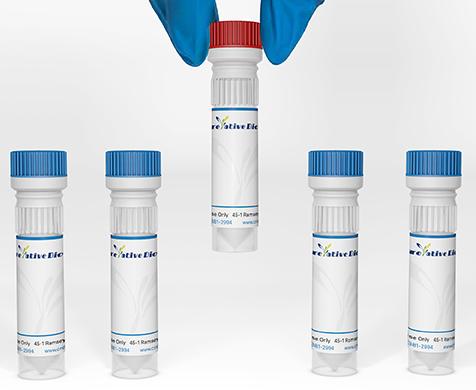The human glucocorticoid receptor DNA binding factor, which associates with the promoter region of the glucocorticoid receptor gene (hGR gene), is a repressor of glucocorticoid receptor transcription. The amino acid sequence deduced from the cDNA sequences show the presence of three sequence motifs characteristic of a zinc finger and one motif suggestive of a leucine zipper in which 1 cysteine is found instead of all leucines. The GRLF1 enhances the homologous down-regulation of wild-type hGR gene expression. Biochemical analysis suggests that GRLF1 interaction is sequence specific and that transcriptional efficacy of GRLF1 is regulated through its interaction with specific sequence motif. The level of expression is regulated by glucocorticoids. [provided by RefSeq, Jul 2008]
Full Name
Rho GTPase Activating Protein 35
Function
Rho GTPase-activating protein (GAP) (PubMed:19673492, PubMed:28894085).
Binds several acidic phospholipids which inhibits the Rho GAP activity to promote the Rac GAP activity (PubMed:19673492).
This binding is inhibited by phosphorylation by PRKCA (PubMed:19673492).
Involved in cell differentiation as well as cell adhesion and migration, plays an important role in retinal tissue morphogenesis, neural tube fusion, midline fusion of the cerebral hemispheres and mammary gland branching morphogenesis (By similarity).
Transduces signals from p21-ras to the nucleus, acting via the ras GTPase-activating protein (GAP) (By similarity).
Transduces SRC-dependent signals from cell-surface adhesion molecules, such as laminin, to promote neurite outgrowth. Regulates axon outgrowth, guidance and fasciculation (By similarity).
Modulates Rho GTPase-dependent F-actin polymerization, organization and assembly, is involved in polarized cell migration and in the positive regulation of ciliogenesis and cilia elongation (By similarity).
During mammary gland development, is required in both the epithelial and stromal compartments for ductal outgrowth (By similarity).
Represses transcription of the glucocorticoid receptor by binding to the cis-acting regulatory sequence 5'-GAGAAAAGAAACTGGAGAAACTC-3'; this function is however unclear and would need additional experimental evidences (PubMed:1894621).
Biological Process
Axonal fasciculation Source: UniProtKB
Axon guidance Source: UniProtKB
Camera-type eye development Source: Ensembl
Cell migration Source: UniProtKB
Cellular response to extracellular stimulus Source: UniProtKB
Central nervous system neuron axonogenesis Source: UniProtKB
Establishment or maintenance of actin cytoskeleton polarity Source: UniProtKB
Forebrain development Source: Ensembl
Mammary gland development Source: UniProtKB
Negative regulation of Rho protein signal transduction Source: ARUK-UCL
Negative regulation of vascular permeability Source: Ensembl
Neural tube closure Source: Ensembl
Neuron projection guidance Source: UniProtKB
Positive regulation of cilium assembly Source: UniProtKB
Positive regulation of neuron projection development Source: UniProtKB
Regulation of actin cytoskeleton organization Source: UniProtKB
Regulation of actin polymerization or depolymerization Source: UniProtKB
Regulation of axonogenesis Source: UniProtKB
Regulation of cell shape Source: Ensembl
Regulation of small GTPase mediated signal transduction Source: Reactome
Signal transduction Source: InterPro
Wound healing, spreading of cells Source: UniProtKB
Cellular Location
Cilium basal body; Cytoplasm; Nucleus; Cell membrane. In response to integrins and SDC4 and upon phosphorylation by PKC, relocalizes from the cytoplasm to regions of plasma membrane ruffling where it colocalizes with polymerized actin.
PTM
Phosphorylation of Tyr-1105 by PTK6 promotes the association with RASA1, inactivating RHOA while activating RAS. Phosphorylation at Tyr-308 by PDGFRA inhibits binding to GTF2I (PubMed:18829532, PubMed:19393245). Phosphorylated by PRKCA at Ser-1221 and Thr-1226, induces relocalization from the cytoplasm to regions of plasma membrane ruffling and prevents the binding and substrate specificity regulation by phospholipids (PubMed:19673492). In brain, phosphorylated by FYN and SRC (By similarity). During focal adhesion formation, phosphorylated by MAPK1 and MAPK3 at the C-terminal region, probably at Ser-1451, Ser-1476, Thr-1480 and Ser-1483. Phosphorylation by MAPK1 and MAPK3 inhibits GAP function and localizes ARGHAP35 away from newly forming focal adhesions and stress fibers in cells spreading on fibronectin (By similarity). Phosphorylation at Ser-1476 and Thr-1480 by GSK3B requires priming by MAPK and inhibits RhoGAP activity and modulates polarized cell migration (By similarity).



